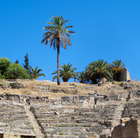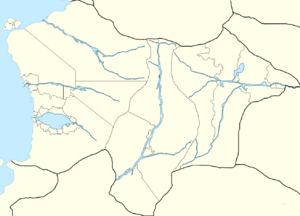Neolithic Moellia (Pacifica)
Map of Moellia showing Neolithic sites (clickable map). | |
| Period | Neolithic |
|---|---|
| Dates | c. 11700 – c. 8000 BC |
| Major sites | Asteria, Rouketa, Nadena, Tento, Krinos, Voreios, Ourona |
| Characteristics | Socioeconomic and architectural developments |
| Preceded by | [TBD] |
| Followed by | [TBD] |
| History of Rhayna (Pacifica) |
|---|
 |
|
|
Neolithic Moellia is the archaeological period referring to the Neolithic period in the region of Moellia, starting in 11,700-8,000 BCE with the arrival of agriculture to the fertile lands of the annually flooded riverbeds and lake coasts. In the neolithic, many advancements spread, as the establishment of annual farming, and the herding of some of the first domestic animals like goats and sheep into the heights of the mountainous chains, as well as the first permanent settlements, and more elaborate forms of architecture, art, cuisine, and tool manufacturing.
Periodization
The neolithic arrived to Moellia with the spread of agriculture around the Katharistis riverbed, with signs of early agriculture tools and grain milling in around 11,700 BCE. It's unclear if agriculture developed in the region, or arrived from outside the zone from excursions or outsider civilizations. However, it's clear that as soon as it started being practised, it rapidly spread, with the last place adopting agriculture being the cultures of the north of Alla-gy in around 8,000 BCE. Usually, the neolithic in the entirety of Moellia is separated into four periods: the Early Neolithic, the Middle Neolithic, the Late Neolithic, and finally the Final Neolithic.
| Period | Approximate date |
|---|---|
| Early Neolithic | 11,700-8,000 BCE |
| Middle Neolithic | 8,000-6,000 BCE |
| Late Neolithic | 6,000-4,500 BCE |
| Final Neolithic | 4,500-3,300 BCE |
Early Neolithic
The early Neolithic period in Moellia marked a transition towards a farming-based economy. Agriculture became the livelihoods of communities, encouraging sedentary lifestyles and permanent settlements. These small settlements were composed of extended family relations, forming tight-knit communities. While farming practices flourished in most of the territory, namely Rhayna and Nea-gy, Alla-gy remained stuck in the Mesolithic, without the adoption of agriculture until 8,000 BCE. In these new settlements, communal life revolved around shared ovens built in open spaces, serving as focal points for social interaction. Moreover, this era witnessed the rudimentary development of pottery firing techniques, laying the foundation for future advancements in pottery-making.
-
Monochrome bowls from Asteria. Early Neolithic period (11700-8000 BC), Archaeological Museum of Rouketa
-
Ancient Moellia Early Neolithic sandstone figurines from Tento, 11700-8000 BC
-
Assortment of Neolithic clay cups, a clay bowl and a plate from Nadena. National Museum of Pzarya
Middle Neolithic
The middle Neolithic starts in Rhayna and Nea-gy with the widespread use of shared architectural characteristics in each region as human populations settle permanently around their crops. In Rhayna and Alla-gy, water channels were carved and built to supply water from rivers and lakes to common areas in settlements.
In Rhayna, the "Asteria-type" house, first developed in the surroundings of the present Asteria City, became popular around the shores of Lake Kryo, influenced by its relatively less grave sandstorms and milder temperatures. These were characterized by stone foundations, and separated rooms that could be used for different functions except for a central one used for cooking, with a characteristic firepit.
In other locations, like Alla-gy, the "Cythasae-type" house became common. These differed from the ones in Rhayna in the size of the windows and the lack of a common area room. These also, unlike the houses in places influenced by the first Neolithic revolution, lacked any rooms dedicated to grain storage, hinting to a widespread herding culture rather than an agricultural one. The Cythasae-type houses were specially common in the north of Alla-gy near the foots of the Prostasia and Defteros mountain ranges, locations historically used for herding. Houses with similar design were also used in the north of Rhayna away from the influence of the Lake Kryo basin, although it's not believed that the populations of northern Rhayna and Alla-gy had any contact with one another.
Finally, the typical house of Nea-gy was radically different from its Aegean counterparts in the desert regions. These, instead of having a flat rooftop, they were cone-shaped and made with dry shrubs, and instead of being made of large sandstone blocks like the ones in Rhayna and Alla-gy, were made of smaller adobe bricks, a radical invention in the Moellian region, although it's not the oldest origin of the brick. These building were composed of a single room with a central firepit, while resources were allocated in common areas of the growing settlements, although this arrangement would change as the populations grew with the arrival of agriculture.
Herding and livestock also became an important part of people's livelihoods, specially for nomad populations and regions with constant supply of fresh water throughout the year, with the first cattle being goats and sheep.
The middle Neolithic ended with the first abstract representation of meander-labyrinth and geometric patterns in jewellery and pottery, which are to this day relevant in Rhaynan culture.
-
Ancient Moellia Neolithic stone figurine, 8000-6000 BC.
Late Neolithic
The Late Neolithic period is characterized by settlement expansion and the intensification of the farming economy, where shrubs and flooded areas were cleared in order to secure grazing fields and arable lands. During this period, new crops were cultivated such as rice, millet, and buckwheat (food was prepared in hearths and ovens usually found inside houses). Animals such as sheep and goats were raised for their meat and milk, while hemp and ramie were used to weave garments. Communities were inhabited by 100–300 individuals, socially organized into nuclear families.
Final Neolithic
The Final Neolithic period entails the transition from the Neolithic farming and stock-rearing economy to the metal-based economy of the Early Bronze Age. This transition occurred gradually when Nea-gy's agricultural population began to import bronze and copper and used basic bronze-working techniques from Eastern Cordilia, which rapidly propagated through nomad populations to the rest of Moellia.
Some remains indicate the propagation of slavery and warfare through Moellia during this period. The slaves would typically be nomads and people captured in settlement invasions. Most of the settlements that show signs of attack weren't abandoned, and the ones that were abandoned were quickly reinhabited by the same people and in some cases by the invading population. However, in some cases, like the one of the ruins of Thassine in Nea-gy, these were permanently abandoned.




